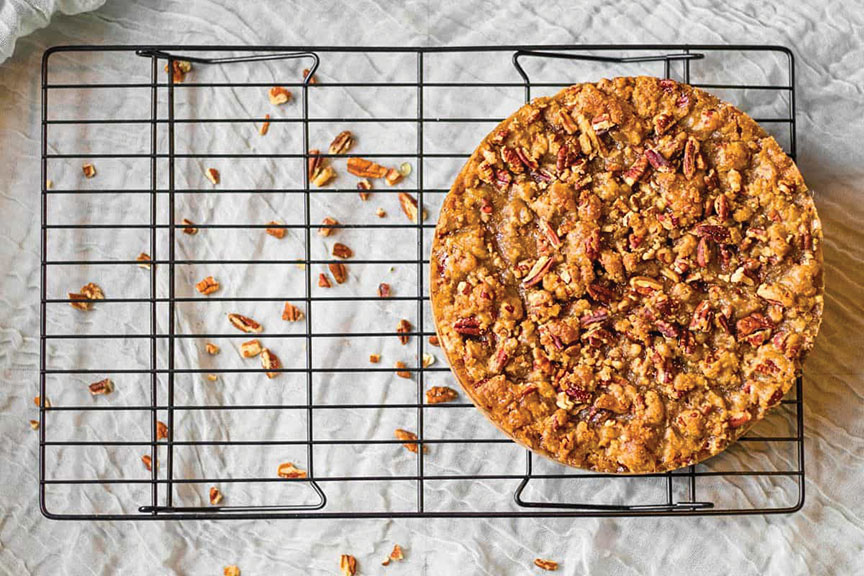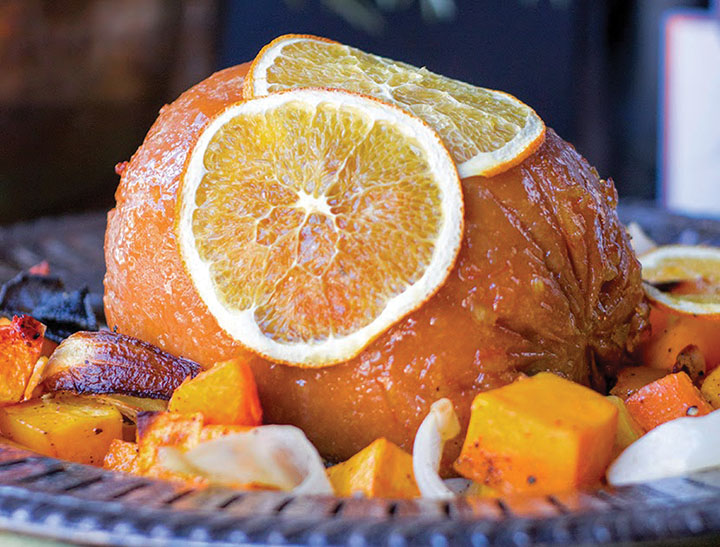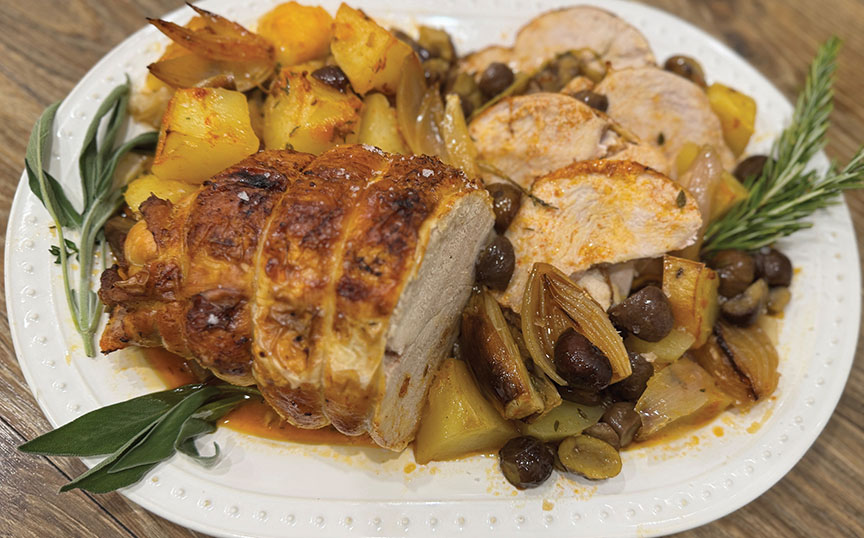
Along with last week’s sauerkraut recipe, a fermented food that’s sure to improve your gut health, there are other recipes I use in a medicinal manner when I am run down or overworked. You’d be hard pressed to find a more medicinal ingredient than garlic, a plant in the onion (Allium) family, related to shallots and leeks, that has been used throughout history for its health properties.
Although garlic originally is thought to be a central Asian discovery, the Egyptians valued garlic’s medicinal properties so much that they buried their dead with the bulbs for use in the afterlife. Rabbinic literature is peppered with references and praise for garlic. A portion of the Talmud states that garlic “satisfies hunger, it warms the body, it illuminates one’s face, it increases seed and it destroys intestinal parasites.” It’s considered a mitzvah to eat foods loaded with garlic on Friday nights in many Orthodox communities to enhance fertility and as an essential and effective aid to “create ardor and enhance lovemaking” on Shabbat.
Eating garlic was so much a part of the Jewish identity that Jews were known as “garlic munchers” and the sulfurous smell of the herb was used as an anti-Semitic slur by the Romans who came up with the expression “allium olere” or “stinking of garlic” to identify Jews as people of a lower class. Classic Italian dishes like artichokes braised with garlic became known as “Carciofi all Giudia” or “Jewish-style artichokes.”
Jewish “penicillin” in the form of chicken soup gets its reputation as a health food in part because of the onions and garlic that infuse the broth; the benefits of garlic are indisputable for a wide variety of ailments. Large-scale studies have proven that regular doses of garlic may lower blood pressure, reduce cardiac events, increase bone health, help with athletic performance and fatigue, reduce the severity of colds and flus, and may even prevent Alzheimer’s and dementia. And even if it didn’t contain manganese, B vitamins, vitamin C, selenium and calcium, garlic enhances the flavor of so many dishes, the fact that it’s so good for you is just a bonus.
One of my favorite garlic delivery systems is pesto sauce. Pesto originated in Genoa in the Liguria region of Italy. The word “pestâ” means to pound or to crush in Italian and, in a traditionally made pesto, the ingredients are ground in a mortar and pestle — pestâ, pestle, pesto — get it?
The benefits of garlic are indisputable for a wide variety of ailments.
Pesto is a mix of herbs combined with cheese, nuts and a good quantity of another great health food, olive oil, to make it more fluid. It’s usually then served over pasta but it can be used to top soup as in the great French Pistou, spread on bread or drizzled on vegetables. Although pesto can be made with a variety of herbs and nuts, I find the classic mixture of Italian basil, garlic, pine nuts, Parmesan and extra virgin olive oil a hard combination to improve upon.
The only downside to the savory, incredible powerhouse of nutrients is garlic breath. No one likes to smell like garlic, and there are many people who cannot handle the odor. I’m conscious of this when making pesto at the embassy. One day, while whipping up a huge batch of pesto for a lunch special, I started to think about how to prevent people from suffering through their co-workers’ garlic breath during afternoon meetings.
That’s when I took a page from the French playbook and added a whole bunch of chopped parsley to the mix. Parsley does two important things to a pesto. First, it keeps the sauce a vibrant green color but second, and more importantly, it neutralizes some of that raw garlic sharpness that can do a number on our stomachs as well as our non-garlic eating companions or co-workers.
Now, I never make pesto any other way because the parsley mellows the pesto and makes it much more kiss friendly. In addition, a small amount of fresh lemon juice, when added to the raw garlic, although not traditional, goes a long way in mellowing out the piquancy of the garlic.
At home, I use my mortar and pestle to make pesto but that’s impractical when making vast quantities of the sauce because pounding that much basil and parsley is too much work. On the other hand, if you don’t overprocess, a food processor with the regular blade insert makes short work of pesto and allows you to use the abundance of basil in your garden or a fresh bunch you may find in the farmers market.
The following recipe will leave plenty of leftover pesto to freeze. You can double or halve the recipe but I always double it. Pesto can hold in the fridge with a layer of olive oil on top for at least a week and can be frozen in jars or containers indefinitely.
It can’t be beat for a quick pasta, to serve over steamed vegetables, as a spread for fresh bread or swirled into eggs. I particularly love it as a topping for zucchini noodles (if you don’t own a spiralizer yet, get one!) or even on top of grilled fish such as salmon or trout.
It packs a hefty nutritional punch from the basil, parsley and garlic, which makes it high in antioxidants along with a good olive oil; it’s probably one of the most detoxifying and absurdly tasty things you can eat.
With the addition of the parsley and lemon to prevent garlic breath, this is one case where you should feel practically obligated to kiss and tell.
Kiss-Friendly Pesto
20 cloves garlic, peeled
15 tablespoons untoasted pine nuts (if unavailable, use cashews)
15 ounces fresh Italian basil
4 ounces curly or flat-leaf parsley
10 ounces grated Parmigiano-Reggiano
(for dairy-free version, substitute 5 ounces nutritional yeast)
4 tablespoons fresh lemon juice
2 1/2 cups mild-tasting extra virgin olive oil (preferably Italian)
5 pinches sea salt (be cautious, cheese is salty)
5 healthy grinds black pepper (optional)
2 ounces grated Parmesan (or nutritional yeast) for garnish (optional)
Pulse garlic in food processor until finely chopped.
Add pine nuts and pulse again until chopped.
Add basil and parsley and continue to pulse until the pesto has reached a rough, rustic consistency. Pulsing mimics a pestle pounding ingredients.
Add Parmesan cheese and lemon juice and pulse a final time to combine. If needed, scrape down the sides of the processor a few times to incorporate ingredients.
Place mixture into a bowl and drizzle in olive oil, stirring to incorporate the oil. Season with salt and pepper to taste.
Pesto is a raw sauce and shouldn’t be cooked but rather, gently heated. If serving pesto over pasta or zucchini noodles, heat noodles in a pan with a generous amount of pesto and a few tablespoons of pasta cooking water to make it come together and bind into an emulsion.
Grate additional Parmesan on top (or a sprinkling of nutritional yeast) and drizzle with a bit more olive oil.
Makes 4 cups.
Yamit Behar Wood, an Israeli-American food and travel writer, is the executive chef at the U.S. Embassy in Kampala, Uganda, and founder of the New York Kitchen Catering Co.

































